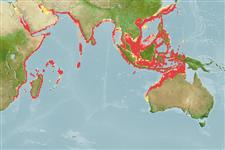Common names from other countries
>
Eupercaria/misc (Various families in series Eupercaria) >
Nemipteridae (Threadfin breams, Whiptail breams)
Etymology: Parascolopsis: Greek, para in the side of + Greek, skolos = stake + Greek, ops = appearance (Ref. 45335).
More on authors: Jordan & Richardson.
Issue
Distribution of this species is being updated. Use Stocks definition as guide for species range.
Environment: milieu / climate zone / depth range / distribution range
Ökologie
seewasser demersal; standorttreu; tiefenbereich 25 - 264 m (Ref. 9820). Tropical; 30°N - 28°S, 31°E - 136°E (Ref. 3810)
Western Pacific: southern Japan, Taiwan, the Philippines and Indonesia (northern Sulawesi),
Size / Gewicht / Alter
Maturity: Lm ? range ? - ? cm
Max length : 35.0 cm TL Männchen/unbestimmt; (Ref. 5450); common length : 35.0 cm TL Männchen/unbestimmt; (Ref. 5450)
Rückenflossenstacheln (insgesamt) : 10; Rückenflossenweichstrahlen (insgesamt) : 9; Afterflossenstacheln: 3; Afterflossenweichstrahlen: 7. Head scales reaching forward to between middle of eyes. Posterior margin of preopercle more or less vertical, or sloping forward slightly. Lower limb of preopercle naked. Posterior margin of suborbital serrate, a small spine at upper corner. Pectoral fins long, reaching to or almost to level of anus. Pelvic fins long, reaching to level of anus. Color: Body pinkish. An elongate blotch at origin of lateral line. Upper axis of pectoral fin black. Pectoral and caudal fin yellowish.
Benthic on sand or mud bottoms in offshore waters (Ref. 30573, 48635). Feeds mainly on benthic invertebrates. Minimum depth reported taken from Ref. 30573.
Life cycle and mating behavior
Maturities | Fortpflanzung | Spawnings | Egg(s) | Fecundities | Larven
Miyamoto, K., C.D. McMahan and A. Kaneko, 2020. Parascolopsis akatamae, a new species of dwarf monocle bream (Perciformes: Nemipteridae) from the Indo-West Pacific, with redescription of closely related species P. eriomma. Zootaxa 4881(1):91-103. (Ref. 123359)
IUCN Rote Liste Status (Ref. 130435)
CITES (Ref. 128078)
Not Evaluated
Bedrohung für Menschen
Harmless
Nutzung durch Menschen
Fischereien: kleinfischerei
Tools
Zusatzinformationen
Download XML
Internet Quellen
Estimates based on models
Preferred temperature (Ref.
115969): 19.8 - 28.1, mean 24.9 (based on 677 cells).
Phylogenetic diversity index (Ref.
82804): PD
50 = 0.5002 [Uniqueness, from 0.5 = low to 2.0 = high].
Bayesian length-weight: a=0.02089 (0.01189 - 0.03673), b=2.99 (2.84 - 3.14), in cm Total Length, based on LWR estimates for this species & (Sub)family-body (Ref.
93245).
Trophic level (Ref.
69278): 4.2 ±0.29 se; based on food items.
Widerstandsfähigkeit (Ref.
120179): mittel, Verdopplung der Population dauert 1,4 - 4,4 Jahre. (Preliminary K or Fecundity.).
Fishing Vulnerability (Ref.
59153): Low vulnerability (25 of 100).
